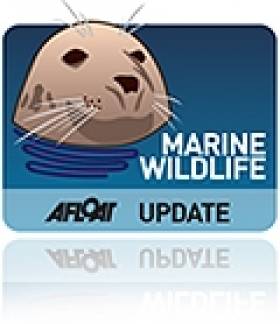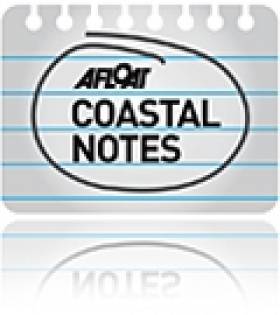Displaying items by tag: flooding
Storm Eva Prompts Status Orange Wind Warning For Irish Coastal Waters
#StormEva - A Status Orange gale warning is in effect for all Irish coastal waters as the fifth winter storm of the season moves in from the Atlantic today (Wednesday 23 December).
Storm Eva will see south to southwest gales or strong gales develop this afternoon on all coastal waters and on the Irish Sea, with winds reaching storm force at times on coasts from Valentia to Erris Head to Malin Head, according to Met Éireann.
The western counties of Donegal, Galway, Mayo, Sligo and Clare will be worst affected, with winds gusting upwards of 100kmh from 1pm till late tonight, and gusts as strong as 120kmh at times between 4pm and 9pm.
Winds will only be marginally less strong throughout the rest of Ireland's coastal counties.
Storm Eva comes nearly three weeks after Storm Desmond's heavy rains caused widespread flooding that is still affecting areas along the Shannon catchment from Athlone to Limerick, as RTÉ News reports.
Flooding Remains 'Severe' As Shannon Levels Peak
#Flooding - Flooding in the Shannon catchment is still "severe" according to the National Emergency Coordination Group,
As RTÉ News reports, waters have risen by 2.5cm in the Athlone area, where the Shannon breached its banks before the weekend.
And levels expected to peak on the Lower Shannon later today (Monday 14 December) between Lough Derg and Limerick, which experienced serious flooding in parts of the city not normally affected.
However, as rain persists over coming days, counties in the South and South West remain at risk, as heavy rainfalls "could cause flooding in areas have had no flooding so far".
Meanwhile, at the other end of the waterway, Lough Erne burst its banks in the Enniskillen area at the weekend – rendering a number of roads impassable, as the News Letter reports.
Pumps At The Ready In Portumna As Further Flooding Expected
#Flooding - Met Éireann confirms that further flooding is expected as prolonged falls of very heavy rain begin tonight (Friday 11 December) continuing through Saturday with totals of 30 to 50mm on lower ground.
Towns and villages along the Shannon have been warned to be braced for the worst flooding in that river's catchment for 20 years.
Galway Bay FM reports that four water pumps are already on standby in Portumna, where crews have managed to keep waters from rising over the bridge that connects the south-east Galway town to Tipperary.
Flooding is only the latest issue in the town, as a local councillor has complained about persistent dumping at Portumna Marina from illegally parked vehicles – though the waste has since been removed.
Pollution is also a problem in Clarinbridge, just outside Galway city, where locals fear the area's famous oysters, already downgraded from their 'A' status – allegedly due to runoff from a water treatment plant in Athenry – will be downgraded to the point of shutting down all harvesting. Galway Bay FM has more HERE.
'Flooding in Ireland Will Worsen Without Climate Change Deal' - MEP Kelly
"Ireland will be one of the hardest-hit countries in Europe and suffer more coastal and river flooding incidents in future, if a deal to limit global warming is not achieved in Paris," said Seán Kelly MEP, a member of the European Parliament's negotiating team at the UN's Global Climate Change Conference in Paris this evening (Thursday).
"Unfortunately, many families in Ireland are once again dealing with the terrible consequences of flood damage to homes, farms and businesses. This is a consequence of climate change which will become a more frequent occurrence in future if we do not take urgent action to lower carbon emissions," he said.
The Ireland South MEP told fellow negotiators in Paris that Ireland is particularly vulnerable to flooding because of high rainfall levels and our Atlantic location.
Mr Kelly further cited last year's study by the Joint Research Centre of the European Commission which examined the possible future Climate Change effects if the global temperature rises by 3.5 degrees Celsius.
"Currently, flooding currently affects 160,000 people in Europe every year but the JRC study revealed that that number could increase to 290,000 in future.
"Across all sectors, Climate Change is causing 190 billion euros worth of damage in the EU annually. But the experts predict that figure could double if no action is taken. It is estimated that flood damage alone could account for €10 billion."
"The message is clear. If current global warming continues unabated, Ireland and the rest of the world will suffer from more flooding incidents. That is why we are here in Paris, pressing our global counterparts to compromise and agree on a deal.
"I believe a deal can be done to prevent this kind of nightmare future. Prevention is better than the cure - the amount of money we spend to repair the damages caused by the effects of Climate Change are far greater than what we could invest now in clean technologies and energy infrastructure that accommodates high share of renewables and so on.
"Reducing emissions now can save our environment, prevent unprecedented levels of damage, like that of the flooding witnessed in Ireland in recent days, and save lives in some cases," Mr Kelly continued.
Flood Relief Priority For Defence Forces As Shannon Breaks Banks
#Flooding - The Defence Forces have joined in flood relief efforts in Clare, Limerick and Westmeath as weekend rains risk significant flooding in the region.
As reported yesterday on Afloat.ie, the Shannon Catchment could see its worst flooding in two decades as spring tides exacerbate the effects of last weekend's Storm Desmond, which prompted a rare 'Status Red' warning for rainfall.
RTÉ News reports that the Shannon is already at dangerous levels, with a flood emergency response launched in Athlone after the waterway breached its banks in the Midlands town, threatening 100 homes.
Homes were also evacuated in Clonlara, Co Clare – between the Shannon and the Headache Canal – while the ESB was releasing water at its Inniscarra Dam facility in Cork to manage reservoir levels, warning of a subsequent risk downstream on the River Lee.
Meanwhile, Waterways Ireland has advised boaters to keep their vessels moored during this and other periods of stormy weather "and especially when national weather alerts are in place".
Even when the storms have passed, "users should be aware that the navigations will have changed significantly in nature and character" with the risk of strong currents, rising waters from flash flooding obscuring navigation markers, and falling trees weakened by storm-force winds.
Shannon Catchment Could See Worst Flooding In Years This Week
#Shannon - The worst flooding in two decades could fall upon the Shannon catchment in the coming days as spring tides accentuate the effects of last weekend's Storm Desmond.
According to The Irish Times, the Office of Public Works has told the National Emergency Co-ordination Committee that the River Shannon from Limerick to Athlone is the one area "giving most concern", with all gauging stations on the waterway showing only rising levels.
And spring tides this coming Friday and Saturday (11-12 December) are set to combine with "the fluvial flood wave coming down the Shannon" that is rated "in the severe category", warned the OPW's Jim Casey, who noted that the Erne catchment is also rising.
Meanwhile, the ESB has increased the flow of water from Parteen Weir at Ardnacrusha to help manage the Shannon's flood waters – but this too may lead to flooding of streets in Limerick city and suburbs.
The Irish Times has more on the story HERE.
Locals Come To Rescue Of Donkey Trapped In Floodwaters
#StormDesmond - Mike the donkey has a lot to be cheery about as volunteers for Animal Heaven Animal Rescue helped rescue him from floodwaters in Kilorglin, Co Kerry yesterday (Sunday 6 December).
As TheJournal.ie reports, Suzanne Gibbons from the animal rescuers put out an appeal on social media after she was altered to the fate of the donkey, who had bolted from his field after Storm Desmond blew the gate over and got trapped in a nearby flooded river.
It wasn't long before two local men brought a boat with a rope and life ring to help tow back onto dry land the grateful animal who's since been named after one of his rescuers.
Rising water levels across the country in the wake of Storm Desmond have prompted a marine notice from Waterways Ireland advising all masters and owners of vessels at public harbours, jetties or moorings against boating in extreme conditions such as storm-force winds and heavy rainfall.
Govt 'Stonewalling' New Galway Flood Risk Plans Says Councillor
#FloodRisk - The Government is "stonewalling" new flood plans for at-risk areas near inland waters in Co Galway, according to a county councillor and general election candidate.
As the Galway Advertiser reports, Cllr Anne Rabbitte claims that the Office of Public Works (OPW) has refused to meet with Galway councillors to advise on new flood risk plans for Headford on Lough Corrib, Portumna on Lough Derg and Ballinasloe on the River Suck, a tributary of the Shannon.
As a result, says Cllr Rabbitte, the council is working from draft maps and being "over-cautious" in its estimates, adversely influencing "insurance costs and resale opportunities" for homes in areas not affected by the last serious floods in 2009.
The Galway Advertiser has much more on the story HERE.
Storm Surge, Flooding Concerns Expressed At Galway Port Plan Hearing
#GalwayPort - Severe flooding and storm surges will be the reality for Galway on a regular basis if the project to extend the port goes ahead as planned, the oral hearing into the scheme has heard.
According to The Irish Times, various groups, including Ireland's national trust An Taisce, have expressed fears over the risks to the city and its environs from a rise in sea levels and increased river flow that would be caused by the €126 million port expansion.
These concerns come in spite of the city's harbourmaster stating a year ago that flooding events would occur more regularly "with or without" the port development.
Marine conservation was also a hot button topic at the hearing yesterday (Wednesday 14 January) as Inland Fisheries Ireland and others outlined the potential ill effects on already vulnerable wild salmon stocks and other species in Galway Bay.
The Irish Times has more on the story HERE.
Flood Risk Again for Coastal Clare
#coastalnotes – Clare County Council says it is monitoring the potential risk of coastal flooding later this weekend and on Monday.
The Council says that a tidal surge and accompanying Southwest to West winds will coincide with high spring tidal conditions during the 36-hour period from Sunday morning to Monday evening.
A Council spokesperson stated: "While conditions are not expected to deteriorate to the extent experienced in early January and early February, there is a potential for coastal flooding. We are continuing to liaise with Met Éireann and, if required, further advisories will be issued during the course of the weekend. In the meantime, caution is urged over the coming days in all areas where coastal flooding has previously occurred"






























































